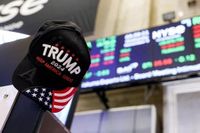In a dramatic turn of events, the U.S. stock market has reacted sharply to President Donald Trump’s recent announcement of sweeping tariffs on imports, reminiscent of the catastrophic economic policies of the late 1920s. Following the president’s declaration, the S&P 500 index experienced a staggering decline of over 10%, raising alarms about the potential for a looming economic recession.
On April 5, 2025, Trump revealed plans to impose a general tariff of 10% on all imports, with additional tariffs targeting specific countries, including 24% on Japan, 54% on China, and 46% on Vietnam. This bold move triggered an immediate market response, with approximately $6.6 trillion in market capitalization evaporating from U.S. stock exchanges over just two days, leading to fears that history might be repeating itself.
The CBOE Volatility Index (VIX), often referred to as Wall Street’s fear gauge, surged to 45.61, marking its highest level since April 2020. The Dow Jones Industrial Average plunged by 2,200 points within the same timeframe, echoing the catastrophic stock market crash of 1929. On 'Black Thursday,' October 24, 1929, the market dropped 11% in a single day, followed by a nearly 25% loss in the subsequent days, ultimately leading to a global depression that saw stock prices plummet by 90% over the next three years.
Financial analysts and historians are drawing parallels between Trump’s current tariff strategy and the high tariff policies of President Herbert Hoover, particularly the Smoot-Hawley Tariff Act, which exacerbated the Great Depression by stifling international trade. The economic journal Barron's noted that while Trump hailed the tariffs as a 'Liberation Day,' the market’s adverse reaction suggests otherwise, highlighting the potential danger of such protectionist policies.
“Even then, there was optimism after the first crash, but it was the beginning of a major decline,” warned economic historian Keynes Pringle. “It is too early to be sure that stock prices have bottomed out now.” This sentiment reflects the apprehension among investors that the current downturn may just be the beginning of a more profound economic crisis.
Market analysts are concerned that these tariffs could hinder U.S. exports and imports, subsequently driving up consumer prices and triggering an economic recession. The historical context of the 1930s trade wars illustrates how retaliatory tariffs led to a significant contraction in international trade, with more than two-thirds of global trade shrinking, resulting in widespread unemployment and political unrest across Europe and Asia.
In light of these developments, the Economist Intelligence Unit issued a report emphasizing that the recent stock market crash cannot be dismissed as a mere blip, suggesting it could be the onset of a more significant economic downturn. Investors are being urged to learn from the history of the Great Depression, as the current economic landscape bears striking similarities to that tumultuous period.
As the market grapples with these uncertainties, the tech industry is also feeling the pinch. Nintendo, for instance, has announced a postponement of the start date for pre-orders of its next-generation console, the Nintendo Switch 2, which was initially set for April 9, 2025. The company is delaying the launch to assess the potential impact of the tariffs and market changes while maintaining the official release date of June 5, 2025.
A spokesperson for Nintendo explained, “In order to evaluate the potential impact of tariffs and market conditions, we will not begin pre-orders for the Nintendo Switch 2 on April 9, 2025.” This delay reflects broader concerns within the electronics manufacturing sector, which is heavily reliant on global supply chains, particularly in regions affected by the new tariffs.
Nintendo primarily manufactures the Switch in China but has been shifting some production to Vietnam and Malaysia to mitigate tariff impacts. The anticipated price of the Switch 2 is set at $449.99 in the U.S., but there are fears that this price could rise if additional tariff costs are imposed.
In Japan, the domestic version of the Switch 2 is priced at 49,980 yen (approximately $500), while the global version that supports multiple languages is set at 69,980 yen (around $700). In South Korea, the console is expected to retail for 648,000 won, with no new announcements regarding pre-order details in that market.
As the situation continues to unfold, Nintendo's official website indicates that applications for the lottery sale of the Switch 2 in South Korea will begin sequentially after April 10, 2025, at participating game retailers. However, applicants must meet specific criteria, including a history of playing Nintendo Switch software and being a paid member of Nintendo Switch Online for at least one year.
The current economic climate is fraught with uncertainty, and as President Trump’s tariff policies take effect, both investors and consumers are left to ponder the potential ramifications. Will the U.S. economy weather this storm, or are we on the brink of a recession reminiscent of the Great Depression? Only time will tell, but the echoes of history serve as a stark reminder of the consequences of protectionist trade policies.





